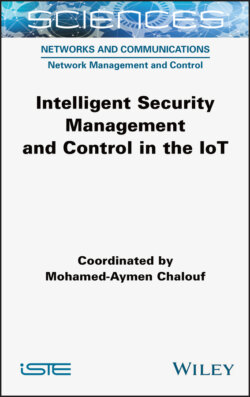Читать книгу Intelligent Security Management and Control in the IoT - Mohamed-Aymen Chalouf - Страница 45
2.4. Model for accessing IoT terminals
ОглавлениеThe model proposed represents an overview of IoT devices executing the ACB algorithm. During the random access attempt, the IoT devices compete for the same available preambles. As the 3GPP standard indicates, the number of preambles N should be an integer as explained in section 2.3 (ETSI 2011).
During each access opportunity (i.e. Random Access Channel, RACH), these preambles are divided into successful preambles, chosen by a single device, in collision, chosen by two or more devices, and free, not chosen by any of these devices.
In what follows, we calculate the average values of these quantities, which we determined in Bouzouita et al. (2015). These will thereafter be used by our algorithms.
Let us define qN=1 – 1/N. The average number of successful preambles NS, during RACH opportunities, is given as follows (this is a classic problem of throwing balls into bins):
[2.1]
where x2 represents the number of devices attempting access. As we have been able to demonstrate in Bouzouita et al. (2019), equation [2.1] is maximized (i.e. derivative equals zero) when the number of devices attempting access simultaneously is
[2.2]
The average number of free preambles NI is given by equation [2.3]:
[2.3]
From [2.1] and [2.2], we obtain the expected number of failed preambles NF:
[2.4]
The modeled system is an approximation of reality in many ways, especially where it concerns the fixed and limited number of access attempts. However, we preferred to simplify the model to make it more tractable (Figure 2.5).
Figure 2.5. System model. For a color version of this figure, see www.iste.co.uk/chalouf/intelligent.zip
The sub-system 1 represents the terminals that wish to connect; the IoT devices belonging to the state variable x1 represent those that can try to connect with a probability p; in case of failure, they go into the waiting state x1,L for a set duration. Sub-system 2 represents the IoT devices that can try to choose a preamble. In case of collision, they can try to access it several times. Each quits sub-system 2 when it succeeds in being the only one to have chosen a preamble or when it reaches the maximum number of attempts (with a rate of θ).
The proposed model is fluid: the quantities involved and the whole numbers are considered to be real (continuous) quantities. The parameters used are listed below:
– x1(t) is the number of waiting devices;
– x1,L(t) is the number of blocked devices, after a failure at the end of an access attempt (i.e. ACB);
– x2(t) is the total number of devices that pass the ACB control and wait to start the random access attempt (RA);
– x2,L(t) is the number of blocked devices, at instant t, after a failed RA attempt, awaiting a new attempt;
– λ is the arrival rate of IoT objects;
– μ is the rate of objects that can reattempt ACB after a failure;
– θ1 is the RA failure rate, which is equal to when θ is equal to 0 (see the point before last);
– θ2 is the rate of objects that can attempt access after a failure;
– θ is the rate at which the device abandons transmission after having reached the maximum number of RA attempts; in a correctly dimensioned system, we should have θ = 0;
– p is the ACB blocking factor.
We are now able to describe the evolution of state variables and basing our study on the model represented in Figure 2.5. The model’s dynamic is described by the following system of differential equations:
[2.5]
In what follows, we suppose that θ = 0, to simplify the model. In fact, a system where the devices often reach the maximum number of attempts is an unstable system, which we naturally try to avoid.
The model described in [2.5] is nonlinear and not affine, in the control. It can easily be demonstrated that the model described is not observable, in view of its state [x1 x1,L x2 x2,L] which cannot be known precisely. It is also not controllable, as the blocking factor p can only act partially on the state. These properties render the synthesis of an optimal controller, guaranteeing the stability of the very complex system, described above, very complex.
Although the state is not observable, it is possible to produce an estimation of the average number of devices attempting access by reversing equations [2.1] and [2.3]. This gives a very noisy measurement, but one which is, nevertheless, useful for IoT blocking as we demonstrated in Bouzouita et al. (2019).
